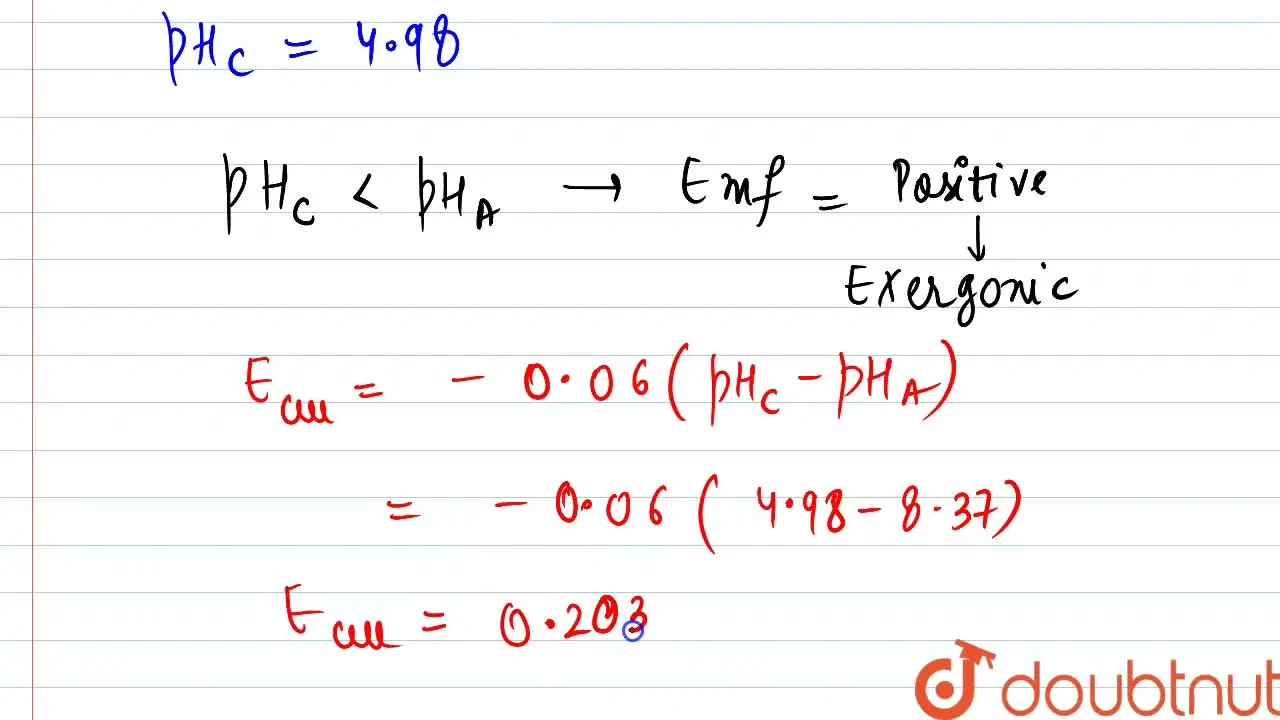Calculate the EMF of the following concentration cells at 30∘C and predict whether the cells are exergonic or endergonic.
Note that at 30∘C , the value of 2.303RTF=0.06.
a.CH3COONa is a salt of WA/SB. Thus
pHa=12(pKw+pKa=logc)
12(14+4.74=log10−2)
=12(14+4.74−2)=8.37
>.Pha=8.37
NH4NOH3 is a salt ofWB/SA. Thus,
pHc=12(pKw−pKb−logc)
=12(14−4.74−log0.2)
=12[14−4.74−log2×10−1]
=12(14−4.74−0.3+1)=4.98.
Since pHc<pHa, therefore,EMFcell=+ve and the cell will be exergonic.
Ecell=−0.06(pHc−pHa)=−0.06(4.98−8.37)
=−0.06×−3.39
=0.2034V
b.CH3COONH4 is salt of WA/WB and its pH is independent of the concentration.
∴pHa=12(pKw+pKa−pKb)
=12(14+4.74−4.74)=7
CH3COONa is a salt fo WA/SB.
∴pHc=12(pKw+pKa+logc)
=12(14+4.74+log10−3)=7.87
Since pHc>pHa
∴EMFcell=−ve and the cell will be endergonic
∴Ecell=−0.06(pHc−pHa)=−0.06(7.87−7)
=−0.06×0.87
=0.05522V
c.CH3COH is a weak acid (WA).
Thus, pHWA=12(pKa−logc)
=12(4.74−log10−1)
=2.87
NH4OH is a weak base (WB).
Thus, pOHwB=(pOH)c=12(pKb−logc)
=12(4.74−log10−2)
=3.37
Thus, pOHwB=pHc=14−3.33=10.63
Since pHc>pHa, therefore, EMFcell=−ve, and the cell will be endergonic.
Ecell=−0.06(pHc−pHa)=−0.06(10.63−2.87)
=−0.06×7.67
−0.4656V
d. Anode reaction: cancer(Ag(s)) rarrAg^(o+)Ag^(o+)(0.1M)+cancel(e^(-))
Cathode reaction :
Ag^(o+)(1M)+cancel(e^(-)) rarr Ag(s)
Cell reaction : ¯¯¯¯¯¯¯¯¯¯¯¯¯¯¯¯¯¯¯¯¯¯¯¯¯¯¯¯¯¯¯¯¯¯¯¯¯¯¯¯¯¯¯Ag⊕(1M)→Ag⊕(0.1M)––––––––––––––––––––––––––––
Since [Ag⊕]c>[Ag⊕]a, therefore , EMFcell=+ve and the cell will be exergonic.
Ecell=Ec−.cell−0.06ncelllog.[Ag⊕][Ag⊕]
=0−0.061log.0.1M1M
Ecell=−0.06[log10−1]=−0.06×−1=0.06V
e. Anode reaction :
2Cl^(c-)(10^(-3)M)rarr cancel(Cl_(2)(g)(1atm))+cancel(2e^(-))
Cathode reaction :
cancel (2Cl(g)(1atm))+cancel(2e^(-))rarr2Cl^(c-)(10^(-2)M)
¯¯¯¯¯¯¯¯¯¯¯¯¯¯¯¯¯¯¯¯¯¯¯¯¯¯¯¯¯¯¯¯¯¯¯¯¯¯¯¯¯¯¯¯¯¯¯¯¯¯¯¯¯¯¯¯¯¯2Clc−(10−3M)→2Clc−(10−2M)––––––––––––––––––––––––––––––––––––––
Since [Clc−]c>[Clc−]a
Therefore, EMFcell=−ve and the cell will be endergonic.
Ecell=Ec−.cell−0.06ncelllog.[Clc−]2c[Cl2a]
=0−0.062log.(10−2)2(10−3)2
=−0.062×2log10=−0.06V
f. Anode reaction :
2Cl^(c-)(10^(-3)M) rarr Cl_(2)(g)(2atm)+cancel(2e^(-))
Cathode reaction : Cl_(2)(g)(1 atm)+cancel(2e^(-)) rarr 2 Cl_(2)(g)(10^(-2)M)
Cellreaction:ul bar(2Cl^(c-)(10^(-3)M)+Cl_(2)(g)(1atm)rarr2Cl^(c-)(10^(-2)M)+Cl_(2)(g)(2atm))<br>E_(cell)=E^(c-)._(cell)-(0.06)/(n_(cell))log.([Cl^(c-)]_(c)^(2)[P_(Cl_(2))]_(a))/([Cl^(c-)]_(a)^(2)[p_(Cl_(2))]_(c)).=0-(0.06)/(2)log.((10^(-2))^(2)xx2atm)/((10^(-3))^(2)xx1atm)<br>=-(0.06)/(2)[log 10^(2)xx2]<br>=-(0.06)/(2)[2 log 10+log 2 ]<br>=-0.03[2+0.3]=-0.03xx2.3=-0.069V<br>Therefore,EMF_(cell)is¬ativeandthecellwillbeendergonic.<br>EMF_(cell)ispositive,if[Cl^(c-)]_(a)gt[Cl^(c-)]_(c)and(p_(Cl_(2)))_(c)gt(p_(Cl_(2)))_(a)
Related Playlists
- BOOK - CENGAGE CHEMISTRY ENGLISHCHAPTER - ELECTROCHEMISTRYEXERCISE - Solved Examples (Electrochemical Cell)36videos
ELECTROCHEMISTRY
- BOOK - CENGAGE CHEMISTRY ENGLISHCHAPTER - ELECTROCHEMISTRYEXERCISE - Solved Examples(Electrolysis And Electrolytic Cells)12videos
ELECTROCHEMISTRY
- BOOK - CENGAGE CHEMISTRY ENGLISHCHAPTER - D AND F BLOCK ELEMENTSEXERCISE - Archives Subjective29videos
D AND F BLOCK ELEMENTS
- BOOK - CENGAGE CHEMISTRY ENGLISHCHAPTER - GENERAL PRINCIPLES AND PROCESS OF ISOLATION OF ELEMENTSEXERCISE - Archives (Subjective)14videos
GENERAL PRINCIPLES AND PROCESS OF ISOLATION OF ELEMENTS
Similar Questions
Calculate the EMF of the following concentration cells a 30∘C and predict whether the cells are exergonic or endergonic. [ Assume Kw does not chage at 30∘C]
Pt|H2(g)(1atm)|H⊕(10−6M)∣∣∣∣H⊕(10−4M)∣∣H2(g)(1atm)∣∣PtView SolutionWhich of the following are concentration cell?
View SolutionIn electrolyte concentration cell:
View SolutionThe e.m.f of the following galvanic cells:
View SolutionWhat is the EMF of a cell?
View SolutionFind the EMF of the concentration cell represented as given below:
 View Solution
View SolutionCalculate the emf of the following concentration cell at 25∘C:
Ag(s)|AgNO3(0.01M)||AgNO3(0.05M)|Ag(s)View SolutionIn which part of the cell is DNA concentrated?
View SolutionWhich does not represent a concentration cell?
View SolutionWhich of the following is not true about emf of a cell?
View Solution


